
(Fr.: ‘running’, ‘flowing’; It. corrente; Eng. corant, coranto).
A dance and instrumental form which flourished in Europe from the late 16th century to the mid-18th, often as a movement of a suite.
The origins of the courante are obscure; a few examples appeared in 16th-century collections printed by Pierre Phalèse (1549, ‘Currendo’), Sebastian Vredeman (1569, ‘Le courante’) and Emanuel Adriaenssen (1584, ‘courrante’), and in manuscript sources such as the Philidor Collection (i, c1570, in F-Pn). By the early 17th century it was a popular dance in both France and Italy and by the end of the century there were two distinct types: the Italian ‘corrente’, a fast triple-metre dance (3/4 or 3/8), usually in binary form with a relatively homophonic texture, balance phrases, virtuoso performance style and a clear harmonic and rhythmic structure; and the French ‘courante’, a ‘majestic’ and ‘grave’ triple-metre dance, usually in 3/2, characterized by rhythmic and metrical ambiguities, especially hemiola, frequent use of modal harmonies and melodies, and a contrapuntal texture. Examples of both styles can be found together in the earliest musical sources that include the dance where the given names seem not to have implied stylistic distinctions, as both styles are labelled ‘corrente’ in Italian sources and ‘courante’ in Franco-Flemish sources.
17th-century courantes were written in one of two mensurations, C3 or 3, and it seems that the mensuration was their earliest distinguishing feature. Dances in 3, whether in French or Italian sources, tend to be more contrapuntal and use hemiola frequently, while those in C3 are almost invariably simple and lively. It is not certain if the two styles had a common ancestor. National taste and idiomatic instrumental styles may have predisposed the French, for example, to stress the contrapuntal and metrical interest possible in one kind of courante, just as the French taste for elegant choreography may have altered the hopping courtship dance of the early 17th century into the sophisticated, serious court dance called ‘courante’ (see illustration). French taste subsequently passed to many German composers, notably those who had strong ties with the French court, like Froberger and J.C.F. Fischer, while Germans like Georg Muffat and Handel, trained in Italy, preferred the simpler and livelier Italian corrente style.
The early 17th-century Italian corrente was a courtship dance combining fixed with improvised step patterns. A general air of gaiety prevailed, the dancers seeming to run rather than walk, moving from side to side in zigzag fashion rather than proceeding backwards and forwards. The steps used in the corrente were described by Cesare Negri (Nuove inventioni di balli, 1604) as consisting mainly of hop–step combinations (e.g. for a step on to the left foot one should hop on the right foot and then step forward on the left). The basic step pattern was four beats long; a variable number of such patterns made up a strain, and two or more strains, each repeated, made a complete dance. Ex.1 shows a typical hop–step pattern described by Negri; the rhythmic shape of the pattern is one of two active beats followed by two relatively restful ones, with the third beat having a feeling of rhythmic climax. Ex.2 shows how four sottopiedi (springing sideways on to the left foot while raising the right backwards, then thrusting the right toe behind the left heel, moving the left foot forward into the air) might be fitted into a corrente. Here the rhythmic pattern is active–rest–active–rest. The corrente usually combined these four-beat patterns, perhaps with some others, to form phrases of eight or 12 beats. Although the steps fit most easily into a triple metre (to accommodate the hop–step pattern) the dance could apparently be performed to music in duple metre as well. Both Negri and Gasparo Zanetti (Il scolaro, 1645) included examples of the corrente that contain both duple and triple measures. Thoinot Arbeau (Orchésographie, 1588) described a dance called ‘courante’ that was to be performed to a duple strain; apparently the dance he discussed was a corrente, for one of the two steps he prescribed, the ‘double a gauche’, is identical to that given in ex.1 (see also Fabritio Caroso, Nobiltà di dame, ed. Sutton and Walker, 1986).

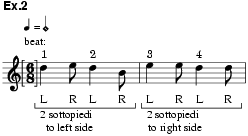
Correntes were common throughout the Baroque period, although they were frequently not labelled as such. The Fitzwilliam Virginal Book included 14 called ‘corranto’, one of them a variation corrente by Byrd. These, and the corantos in later virginal collections (e.g. Elizabeth Rogers’s Virginal Book, 1657), were written in one of two mensurations, C3 or 3 (3/4 or 6/4) in a free-voice texture which often includes points of imitation at the beginnings of strains. Some consist of two or three unrelated strains, each repeated, while others approximate to binary form. Frescobaldi’s correntes (Il secondo libro di toccate, canzone, versi d’hinni, Magnificat, gagliarde, correnti et altre partite, 1627), like those in English sources, appeared in two metres, C3 and 3. Ex.3a shows a typical corrente style written in the former mensuration, clearly presaging the later simple corrente; ex.3b shows Frescobaldi’s typical treatment of the corrente in 3, with signs of the rhythmic ambiguity considered characteristic of the courante. Both styles also appear in Michael Praetorius’s Terpsichore (1612), as do pieces labelled ‘courante sarabande’ and ‘courante bransle’ that do not seem significantly different from the ‘courrants’ themselves. Later Italian composers of the corrente, such as Michelangelo Rossi (1657), Corelli, Vivaldi and Pasquini, tended to prefer the less complicated C3 corrente (eventually written in 3/4), writing in a clear homophonic texture often characterized by rapid figuration in the upper part (ex.4).
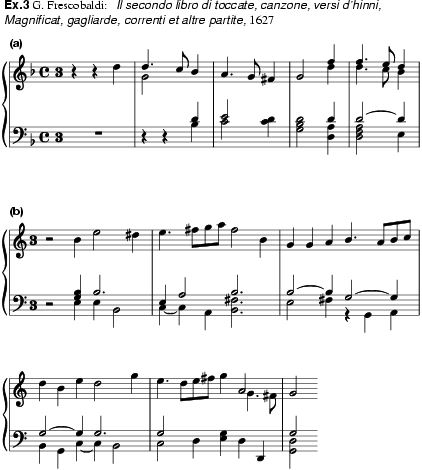
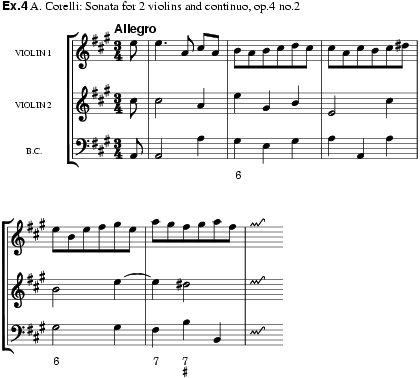
The corrente in C3 was adopted in Germany as one of the standard dances in a suite and as a vehicle for idiomatic display. Scheidt’s Tabulatura nova (1624) includes two pieces called ‘courante 4 voc.’ written in C3, which correspond to the description of the corrente given above. Both show a great deal of motivic play and use points of imitation at the beginnings of phrases, often at the expense of a clear phrase structure, and both feature rapid passage-work. The ‘courente’ movements included by Schein in the suites of Banchetto musicale (1617) are written in 6/4, in a homophonic texture; the occasional use of hemiola in the penultimate bars of sections hints at a preference for the more elaborate kind of corrente found in the works of Frescobaldi. Schein placed the ‘courente’ as the third dance of the suites, between the galliard and the final allemande to which it is often motivically related. In his keyboard suites Handel placed movements called ‘courante’ after the opening allemandes; all are in 3/4, and all share a simple texture, a tendency to rapid movement in the upper part and the binary form of correntes by contemporary Italians. Many of Bach’s ‘courante’ movements are actually correntes as well: in the original engraving of the keyboard partitas (Clavier-Übung, i), movements are clearly labelled either ‘corrente’ or ‘courante’; this distinction has often been omitted by editors. The first, third, fifth and sixth keyboard partitas all include correntes by Bach’s ascription, as do the second, fourth, fifth and sixth French suites, the first and second partitas for solo violin and the first, second, third, fourth and sixth suites for solo cello. These correntes are written either in 3/4 or 3/8 with a simple texture, clear harmonic and rhythmic movement and much triadic passage-work in the upper part (ex.5).
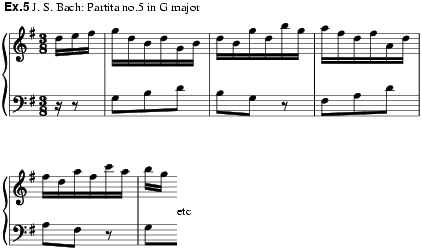
Precise information on the dance movements of the French courante is not available until after 1700, so that it is difficult to ascertain if the French dance was an outgrowth of the much livelier Italian one. At least ten choreographies with music are extant, by French choreographers such as L. Pécour (ex.6) and English choreographers such as Mr Isaac (‘The Northumberland’, Little and Marsh, 1992, no.6220a) and Mr Siris (‘The Brawl of Audenard’, no.1600a). Two types of step were common, both of which created a mood of gravity and dignity. One type of step, the tems de courante, is a noble gesture consisting of a bend, rise and slide. (A plié, or bending of the knees, comes on the final crotchet of a bar, followed by an élevé or rise on the downbeat and a curved slide of the non-weight-bearing foot on the second beat of the bar.) Another type of step, actually a group of three steps, is the pas de courante, made up of a demi-coupé (a plié and an élevé, the latter coinciding with the third minim beat of the bar) and a coupé (a demi-coupé on to one foot and a pas glissé or slide on the other). Ex.6 shows how these steps fit to music in one choreography from the 18th century. According to Pierre Rameau (1725) a small leap might be substituted for the first demi-coupé of the pas de courante, but scholars are unsure whether this applies to all courantes or only to those of Rameau’s time. The courante had the slowest tempo of all French court dances, and was described by Mattheson, Quantz and Rousseau as grave and majestic, Mattheson adding that its typical affection was one of ‘sweet hope and courage’.
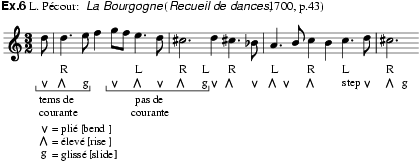
As a dance the courante was probably performed in ballet early in the 17th century. Mersenne quoted the tunes to several courantes in current use (Harmonie universelle, 1636–7); while for at least one of these, La Bocanne, a choreography exists in 18th-century sources (Little and Marsh, no. 1420), the musical style of Mersenne’s examples is not significantly different from that of contemporary Italian correntes. By Lully’s time the courante had become less popular in ballet, and of his more than 250 titled dances only five are courantes. Under Louis XIV, however, the courante became the most prominent dance of court balls, with the king, himself an accomplished dancer, performing the first courante of the evening. It was still being danced at balls in 1725, according to Pierre Rameau, but by then it was no longer of prime importance. Gottfried Taubert, who had earlier described its use as the opening dance at balls in Germany (Rechtschaffener Tanzmeister, Leipzig, 1717, 570–615), also provided three choreographies, two ‘courante simple’ and one ‘courante figurée’ (Little and Marsh, nos.2320, 2340 and 2360); unfortunately, the music is lacking.
Early examples of music for the courante may be seen in the works of 17th-century lutenists such as Robert Ballard, Nicolas Vallet and Ennemond Gaultier. Like the early 17th-century English and Italian examples discussed above (see §2), some of these pieces were written in C3 with regular phrasing, simple texture and no traces of hemiola, while others, written in 3, reveal the contrapuntal interest, heavy ornamentation and continual rhythmic tension that characterized later courantes. Ex.7, from Ballard’s Premier livre d’intabulations pour la luth (1611), is typical of the developing courante in its imitative opening and use of hemiola just before the first cadence. Sung courantes appeared as examples of Brunette and chansons à danser published by Christophe Ballard, L’Affilard and others. From some time in the 1620s or 1630s the courante became a standard part of the French dance suite, appearing between the allemande and the sarabande; this arrangement of dances was also established in the German suite by Froberger. Highly stylized courantes can be found in suites and keyboard collections by Chambonnières, d’Anglebert, Louis Couperin, Marin Marais, Francesco Corbetta, François Couperin and J.-P. Rameau. Ex.8, from Chambonnières’ Pièces de clavessin (1670), shows the courante’s typical rhythmic and metrical fluidity and complicated texture. Rameau’s courantes carried the traits of metrical tension and heavy ornamentation to their logical extremes. Bach used French courantes in the C major orchestral suite, in all the English suites and in the overture in the French style, as well as in the first and third French suites and second and fourth keyboard partitas (ex.9); Bach’s courantes, however, show less rhythmic ambiguity and fewer modal harmonies than those of his French predecessors.
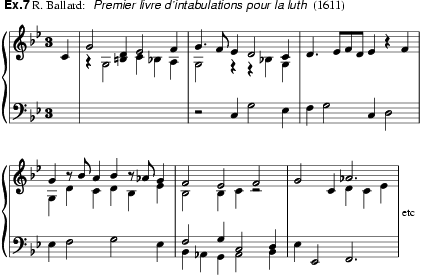
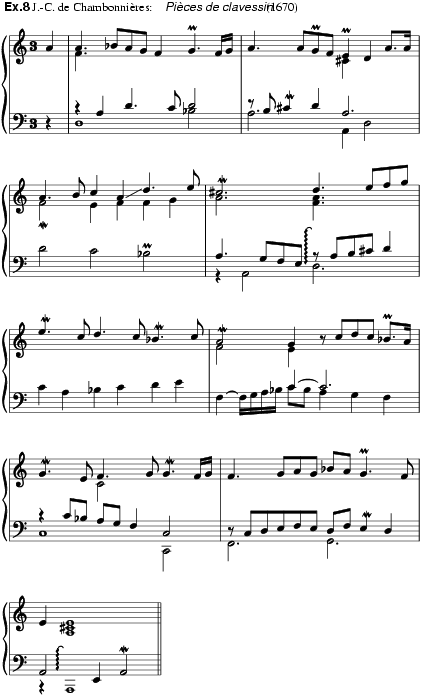
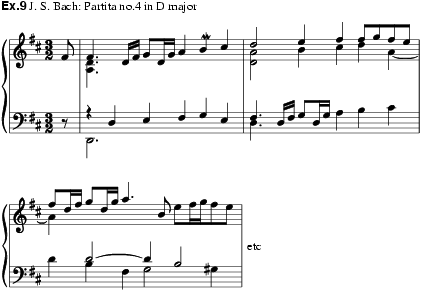
MGG1 (K. Gudewill)
MGG2 (M. Glück)
T. Arbeau: Orchésographie (Langres, 1588; Eng. trans., 1925/R)
C. Negri: Le gratie d’amore (Milan, 1602/R1969 and 1983 in BMB, 2nd ser., civ; ed. and trans. of 1st edn by G.Y. Kendall (DMA diss., Stanford U., 1985))
F. de Lauze: Apologie de la danse (?Paris, 1623/R)
L. Pécour: Recueil de dances (Paris, 1700/R), 43–4
G. Taubert: Rechtschaffener Tanzmeister (Leipzig, 1717), 568–614
P. Rameau: Le maître à danser (Paris, 1725/R; Eng. trans., 1931/R), chaps.26–7
J. Ecorcheville: Vingt suites d’orchestre du XVIIe siècle français (Paris, 1906/R)
P. Nettl: ‘Die Wiener Tanzkomposition in der zweiten Hälfte des 17. Jahrhunderts’, SMw, viii (1921), 45–175
F. Feldmann: ‘Untersuchung zur Courante als Tanz insbesondere im Hinblick auf die Klaviersuiten-Courante J.S. Bachs’, DJbM, vi (1961), 40–57
C. Wassberg: The Courante in Keyboard Music of the Baroque Era (diss., U. of Washington, 1962)
W. Klenz: Giovanni Maria Bononcini of Modena (Durham, NC, 1962)
P. Aldrich: Rhythm in Seventeenth-Century Italian Monody (New York, 1966)
U. Kraemer: Die Courante in der deutschen Orchester- und Klaviermusik des 17. Jahrhundert (diss., U. of Hamburg, 1968)
K.H. Taubert: Höfische Tänze: ihre Geschichte und Choreographie (Mainz, 1968)
O. Mortensen: ‘Über Typologisierung der Couranten und Sarabanden Buxtehudes’, DAM, vi (1968–72), 5–51
W. Hilton: ‘A Dance for Kings: the 17th-Century French Courante’, EMc, v (1977), 160–72
W. Hilton: Dance of Court and Theater (Princeton, NJ, 1981/R)
J. Sutton and F.M. Walker, eds.: F. Caroso: Nobiltà di dame (1600); a Treatise on Courtly Dance (Oxford, 1986)
M. Little and N. Jenne: Dance and the Music of J.S. Bach (Bloomington, IN, 1991), 114–42
M. Little and C. Marsh: La danse noble: an Inventory of Dances and Sources (Williamstown, MA, 1992)
F. Lancelot: La belle dance: catalogue raisonné (Paris, 1996)
MEREDITH ELLIS LITTLE/SUZANNE G. CUSICK